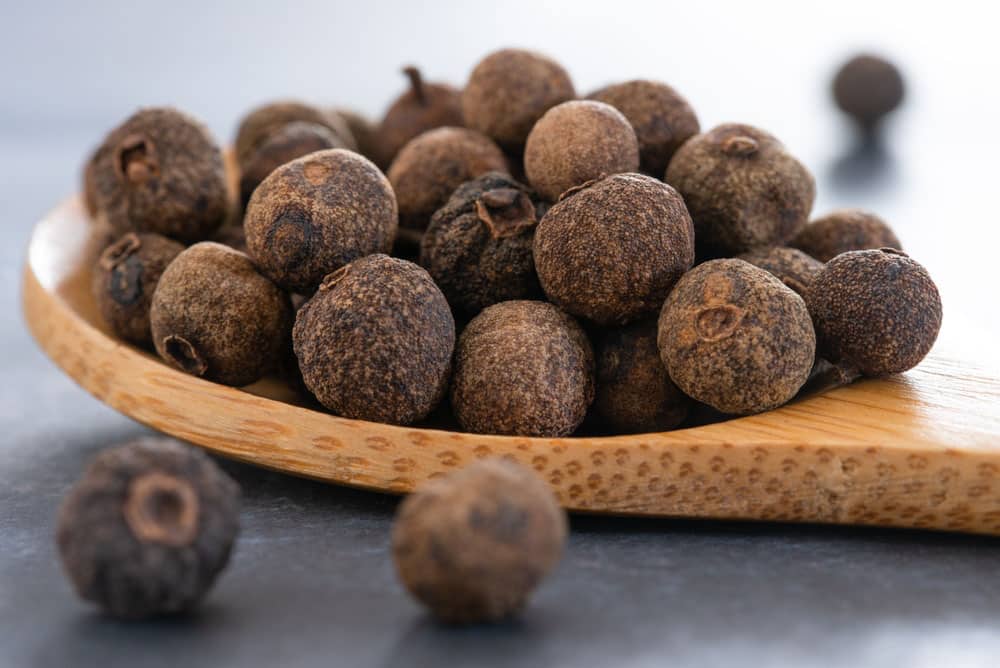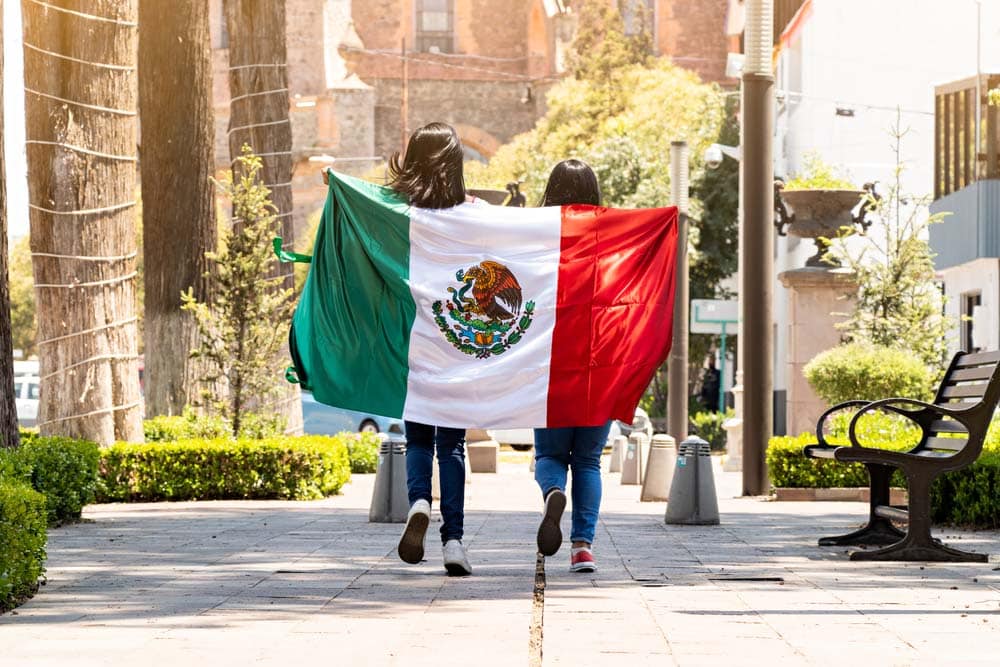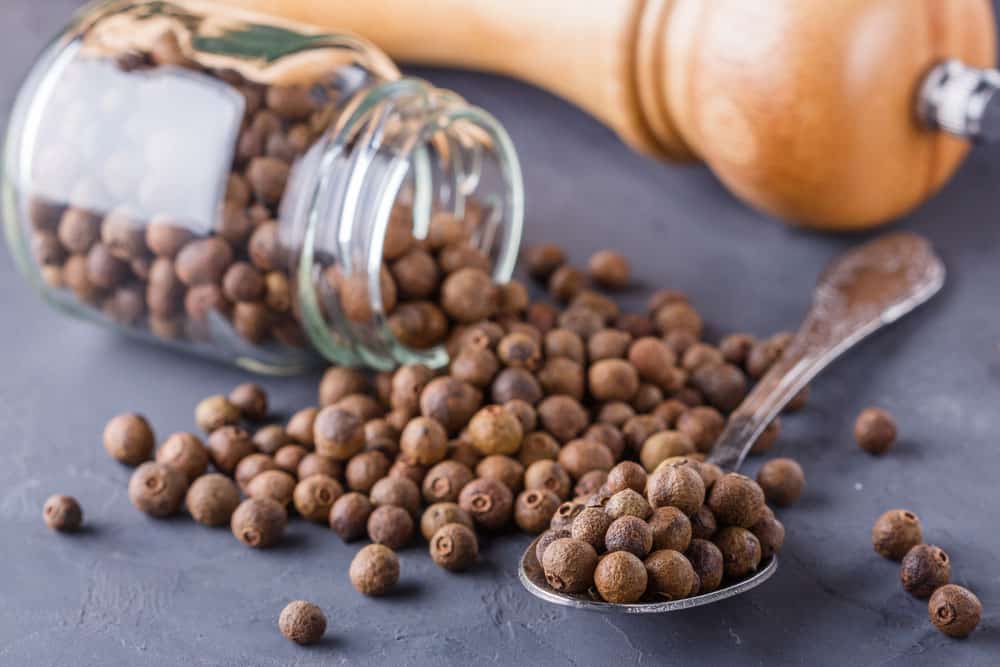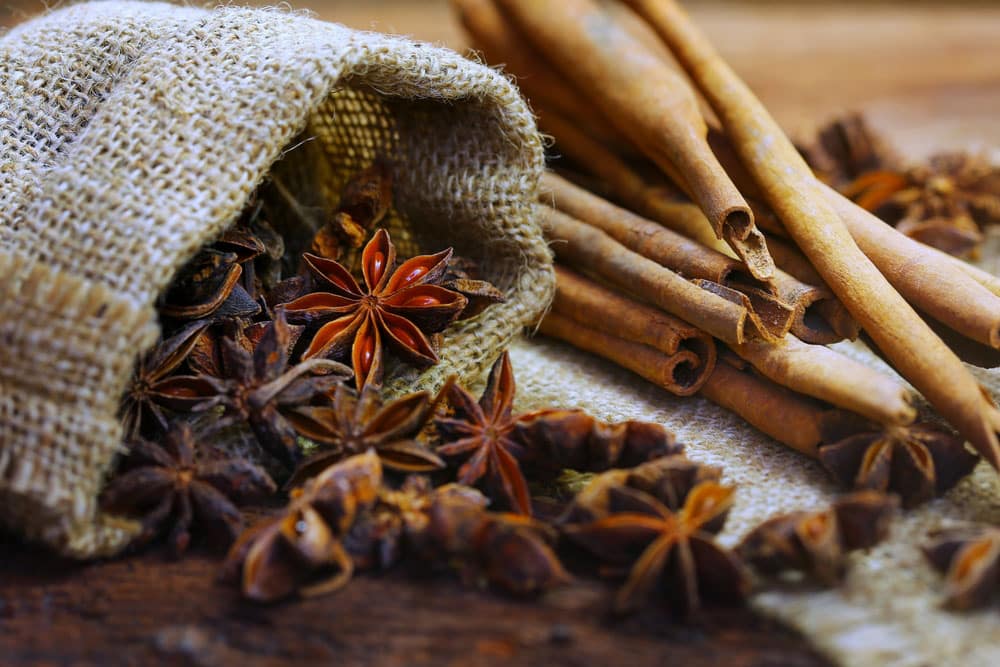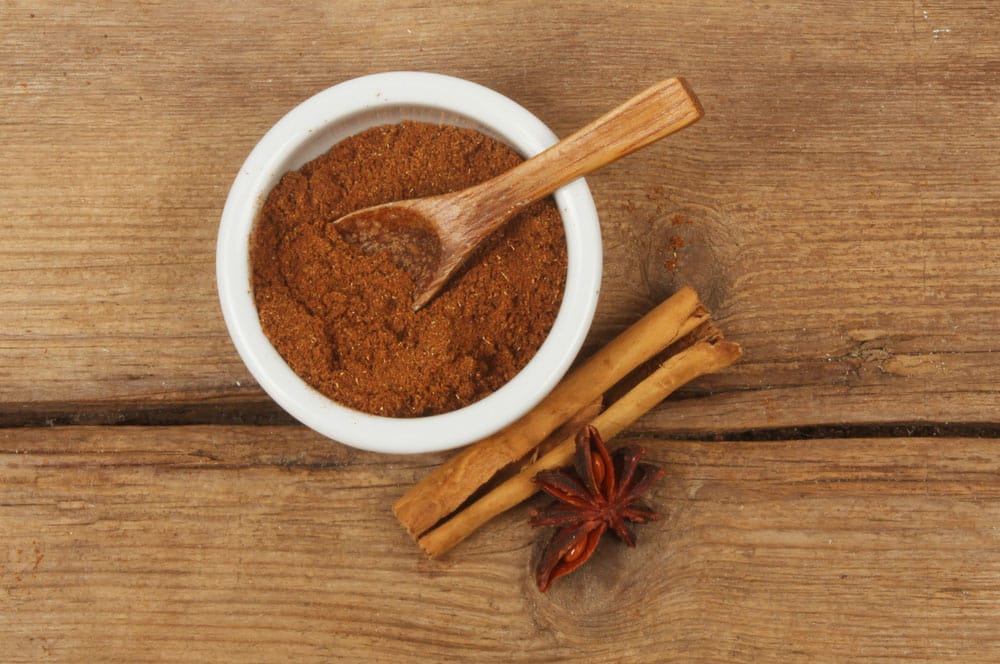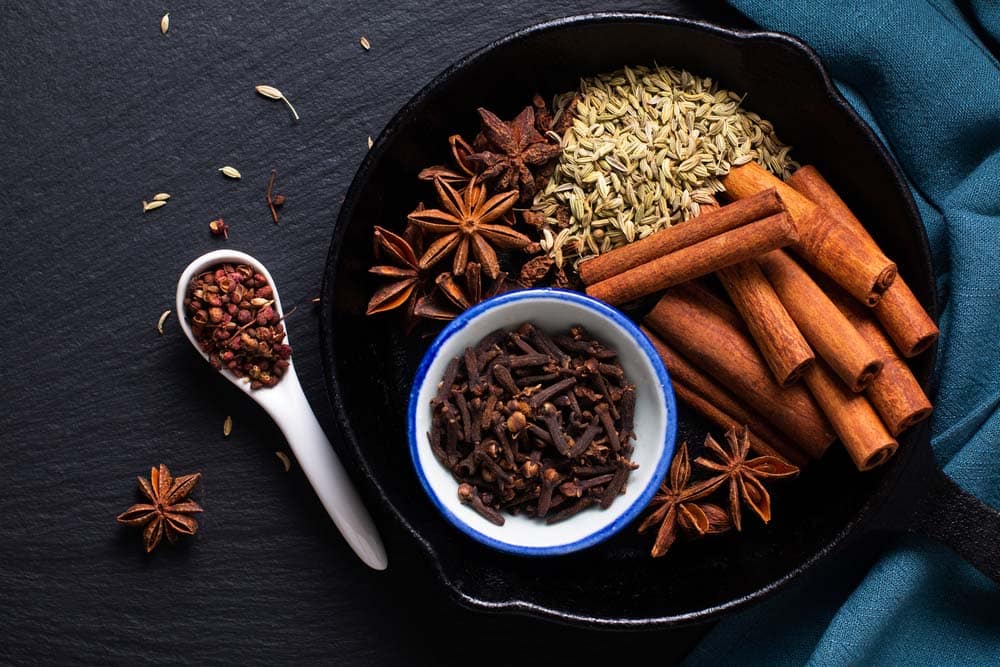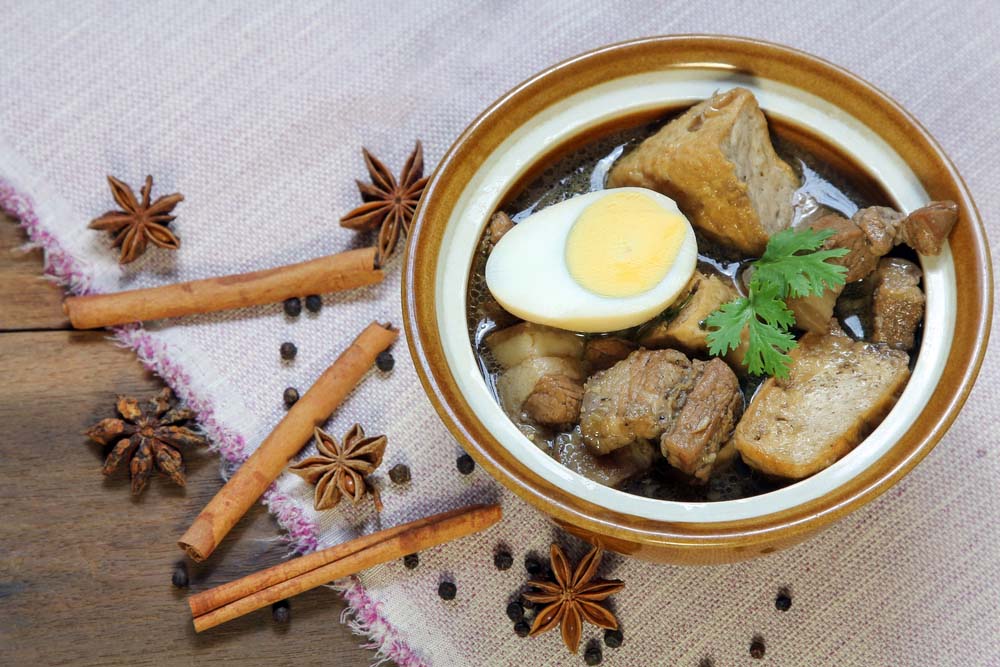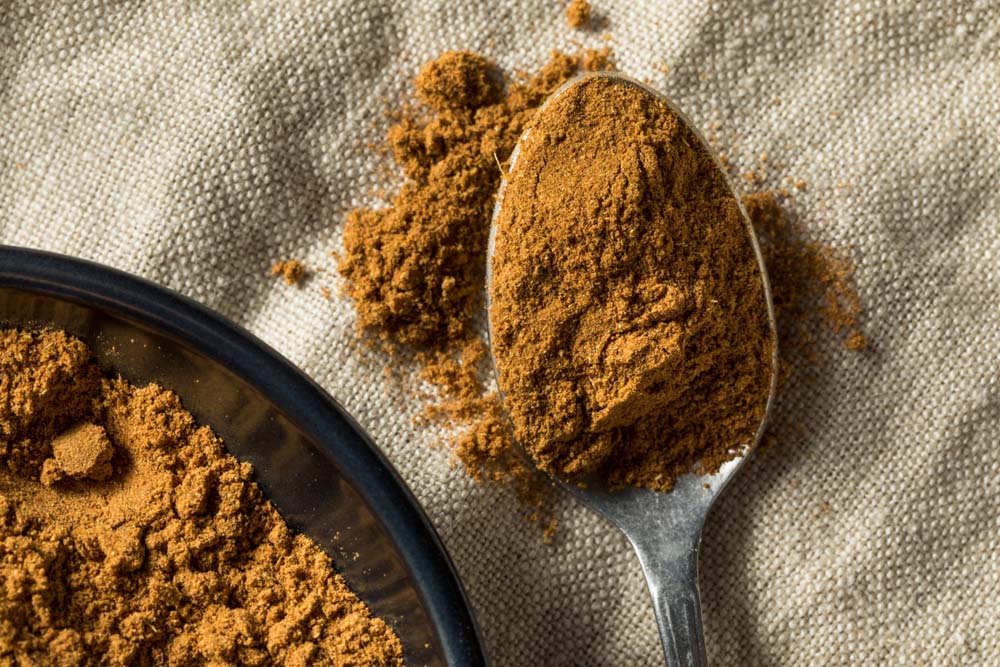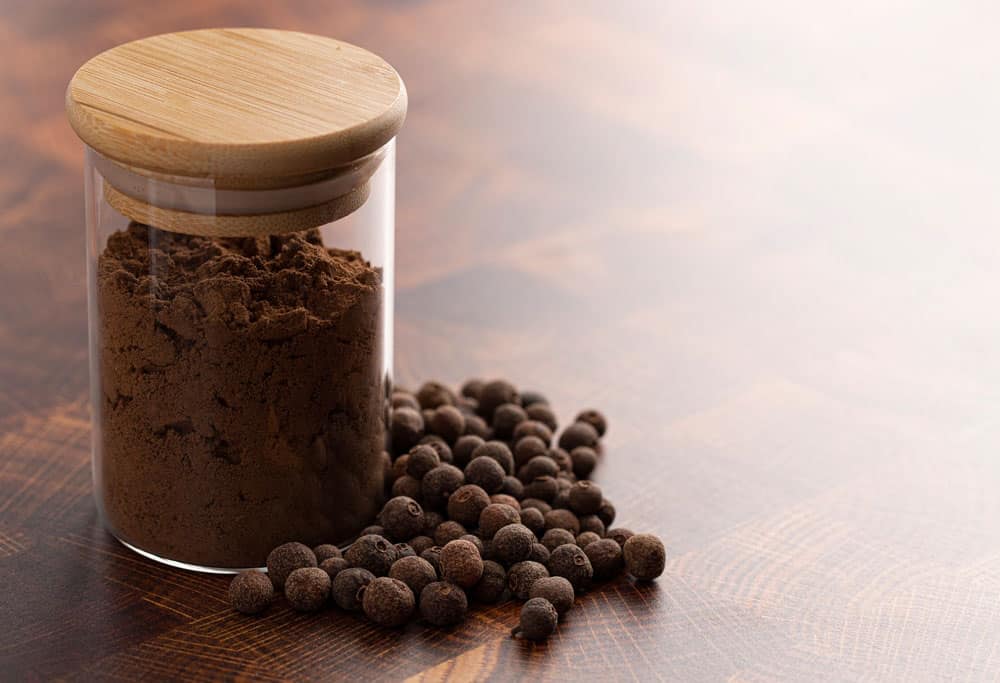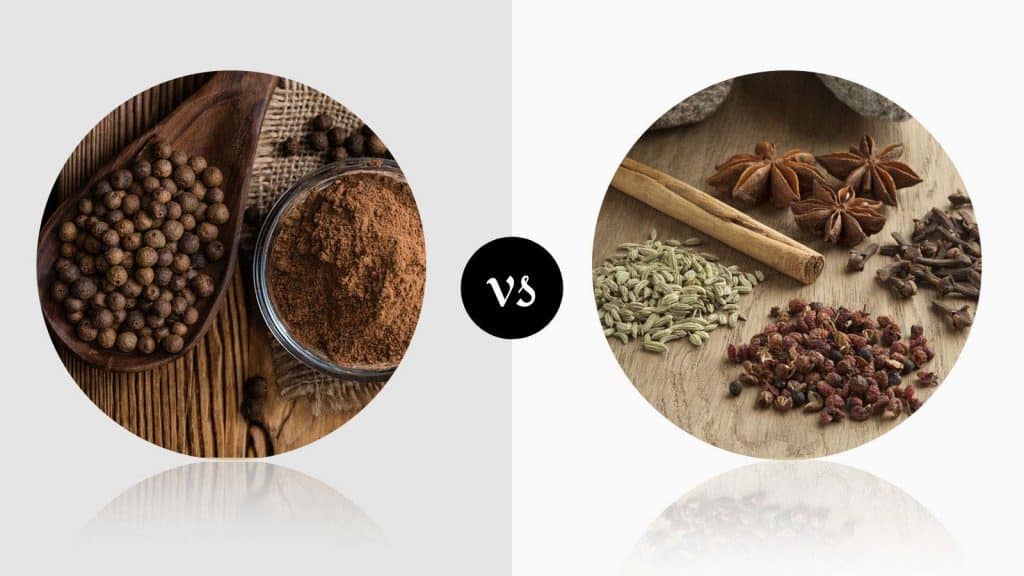
DISCLOSURE: This post may contain affiliate links, meaning when you click the links and make a purchase, I receive a commission. As an Amazon Associate I earn from qualifying purchases.
For all of time, mankind has tried to improve the quality of life. Initially, the focus was on the necessities like food, clothing, and shelter.
However, as we grew wiser and more privileged to a greater range of ingredients, we soon came to realize that the flavor of food relies on the spices and seasonings used. Two of the oldest and most commonly used spices are allspice and 5 spice.
Each has its own distinctive aroma, taste, and properties and is used for particular purposes. The culinary world is filled with recipes relying on these two spices. If you happen to be wondering the difference between allspice vs. 5 spice, we’ve got all the information you need coming up.
Allspice Vs. 5 Spice Comparison
| Allspice | 5 Spice | |
|---|---|---|
| Definition | Dried Unripe Pimenta Dioica (Myrtle Pepper) Berries | Blend Of Five Spices Each Representative Of The Five Elements |
| Origin | Mexico, Central America | China |
| Flavor | Similar To Cloves, Pepper, Cinnamon & Nutmeg | Chinese cassia cinnamon bark, fennel seeds, star anise, Szechuan peppercorns |
| Forms | Whole & Ground | Ground Only |
| Uses | Seasoning For Cuisine From Middle East, Jamaica, Mexico, Central America, North Europe, USA | Quintessential Seasoning For Chinese Cuisine Yet Very Versatile |
| Substitutes | Cloves, Pepper, Cinnamon, Nutmeg | Ground Star Anise, Cloves, Chinese Cinnamon, Sichuan Pepper, Nutmeg, Turmeric, Licorice, Orange Peel |
| Benefits | Anti-Inflammatory, Antiemetic | High Level Of Antixodidants, Better Bile Secretion & Digestion, Improved Vitamin & Fat Absorption, Anti-Inflammatory Benefits, Antiseptic Action |
| Affordability | $2.25 - $5 Per Ounce | $5 Per Ounce+ |
Allspice Vs. 5 Spice
While there are distinct similarities other than the likeness in name, allspice vs. 5 spice presents two entirely different spices, each with unique uses, benefits, and flavor notes.
Allspice
This member of the myrtle family is one of the world’s favorite spices, carrying a far more complex flavor than most others. Here’s a breakdown of allspice, what it tastes like, and how it’s used.
Definition
Allspice is a spice that is made by grinding the dried green unripe berries of Pimenta dioica, a plant also known as myrtle pepper, pimento, pimenta, or the Jamaican pepper. Once dried, the fruit resembles massive smooth peppercorns.
Origin
The Allspice mid-canopy tree is native to Mexico and Central America but is today cultivated in numerous warm regions of the world.
Flavor Profile
Allspice is treasured for carrying a flavor profile resembling a combination of cloves, pepper, cinnamon, and nutmeg.
Forms
There is both whole and finely ground allspice available, although ground allspice is far more common and easier to use. The whole form is best for brine, pickling, and in certain soups and stews.
Thanks to its milder taste, ground allspice is the best choice for cakes, pies, and gingerbread.
Uses
You’ll find allspice to be a staple in Middle Eastern, Jamaican, Mexican, and Central American cuisine. It’s the core crucial flavor component in Jamaican jerk seasoning.
Middle Eastern and Arabian cuisine use allspice extensively in stews, tomato-based sauces, and meaty dishes. Northern Europe and the USA use the smoky spice in sausages, pickling, curries, chilies, and desserts.
Substitutes
Tasting allspice could easily fool one into thinking you’re eating a blend of cloves, pepper, cinnamon, and nutmeg. Combine equal quantities for a worthy substitute to allspice if you’re all out.
Otherwise, one of the most trusted blends to use as a direct replacement for allspice comes courtesy of The Pioneer Woman herself, Ree Drummond.
Mix three and a half teaspoons of regular ground cinnamon with one and a quarter teaspoons of nutmeg and a pinch of ground cloves, and you’ve got a reliable allspice substitute for sweet and savory recipes.
Benefits
Allspice holds many proven medical benefits. It is known to alleviate inflammation, and the compound Eugenol which is responsible for its spiciness is an effective antiemetic or substance that quells nausea.
Affordability
[amazon box=”B088Q2PM3Q”]
Ground Chinese five-spice retails for between $2.25 and $5 per ounce in the United States, making it slightly more affordable than allspice.
Five Spice
With a flavor to represent each of the five natural elements, Chinese Five-Spice powder is a mixture that’s indispensable to many different types of cuisine. Let’s break down the main tastes and characteristics of 5-Spice.
Definition
5 Spice or five-spice powder is a traditional Chinese blend of five distinctive flavors that are used extensively throughout all Chinese cuisine. It has also become popular in Hawaiian and Vietnamese cooking. Five-spice includes Chinese cinnamon, fennel, star anise, and cloves.
The fifth and final spice is at the discretion of the person doing the blending and typically ends up being ginger, white pepper, or Sichuan peppercorns. Each spice grants a different base flavor out of the five flavors, namely sweet, bitter, sour, salty, and umami.
Origin
To this day, we don’t know the precise origins of five-spice. Many believe that the treasured spice blend arose during the fourth century BCE.
During this period, China was on the search for an endless versatile spice that embodied flavors representative of the five elements and their corresponding tastes.
Flavor Profile
Chinese 5 spice combines Chinese cassia cinnamon bark, fennel seeds, star anise, and Szechuan peppercorns. The Chinese cinnamon grants a mild cinnamon flavor with distinctive floral notes. Fennel resembles celery. Star Anise is closest to licorice.
Szechuan peppercorns are akin to very hot black pepper with citrus and lavender undertones. There are many other variations of five-spice available, but each includes a sweet, bitter, sour, salty, and umami spice.
Forms
You will only find ground five-spice. Whole spices are never supplied in this blend. There are two types of Chinese cinnamon bark commonly found. Cassia is often referred to as Saigon cinnamon and is an acceptable spice to include.
However, Ceylon cinnamon is considered to be the most authentic and oldest type of bark harvested from an entirely different tree. The Ceylon cinnamon tree, Cinnamomum Verum, is better known as the true cinnamon tree and carries the ideal subtle flavor for five-spice.
Both varieties will be found in popular blends.
Uses
Chinese 5 spice offers superb nutritional value due to the diversity of spices used. It is also extremely versatile and is used across a range of cooking and baking applications. Five-spice goes particularly well with fatty food and all types of meat.
It’s often added to fish and poultry dishes in Chinese cuisine. Despite the many meaty uses, vegans and vegetarians will find 5 spice extremely healthy and useful. Whether basting steak or seasoning bean curd, five-spice is ideal.
The combination of spices included in 5 spice grants a rich reddish-brown color to any meal it’s included in. Five-spice is versatile enough to be used as a seasoning for rubs, breading, stews, soups, and all types of cuisine.
It’s a fantastic spice to add depth of flavor to both sweet and savory dishes.
Substitutes
If you’re all out of five-spice powder, try to include as many of the base flavors as possible. Combine ground star anise, cloves, Chinese cinnamon, Sichuan pepper, and fennel seed individually.
Alternatively, feel free to include ground ginger, nutmeg, turmeric, licorice, or orange peel for traditional infusions typically found in five-spice powder.
Benefits
The traditional Chinese blend of Szechuan pepper, fennel, cinnamon, star anise, and clove has a proven high antioxidant capacity and is valued for its ability to quell indigestion quickly. There are several studies confirming the health benefits of the Chinese five-spice.
Its bitterness promotes bile secretion, which helps one’s digestion function optimally while promoting better absorption of vitamins and fats.
The cloves present in five-spice contain high levels of antioxidants which provide widespread anti-inflammatory benefits, and antiseptic properties, which are highly active against microbial infections.
The blend is even suitable for those with celiac disease thanks to containing absolutely no gluten.
Affordability
[amazon box=”B00ZK8YJD6″]
Ground allspice retails for an average of $5 per ounce in the United States.
AllSpice Vs. 5 Spice, Major Differences
To wrap up, the major difference between allspice vs. 5 spice is its origin – allspice comes from the ground dried berries of a tree, whereas five spice is a blend originating in Chinese cuisine that’s made up of five individual spices.
You’ll only have five powdered, 5 spice powdered as it’s a mixture of numerous different spices. Allspice is available whole or powdered. The flavor profile is completely different, but both boast equally as extensive use-profiles throughout various recipes and cuisine.
Seasoning is vitally important to every meal but doesn’t make the mistake of using allspice or 5 spice in the place of its counterpart by accident.
